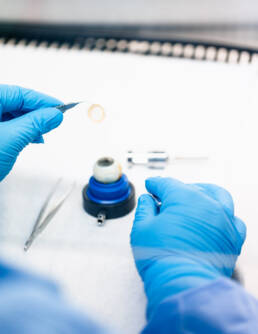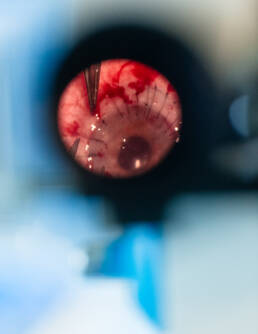MEDICAL PR PHOTOGRAPHY HANNOVER | HAMBURG | KUALA LUMPUR | WORLDWIDE
The eye delivers 80 percent of the information we need to perceive the world, and it takes precedence over all other senses. When our visual perception no longer functions properly, this inevitably affects our everyday life, our mobility and our well-being. Visual restriction means a permanent fight against the barriers of a strongly visual world.
Infections, injuries and congenital diseases can cloud the cornea, which might lead to severe visual impairment. Such a clouding can be removed by means of a transplant and replaced by the intact cornea of a deceased person. Such keratoplasties (corneal transplantations) are carried out several thousand times a year in Germany—with a success rate of over 90%. Nevertheless, in contrast to the more well-known organ donations, awareness of such tissue donations is relatively low. The German Society for Tissue Transplantation (DGFG) coordinates all transplants in the Federal Republic of Germany and advocates better education on the subject within society.
In this Medical PR Photography series the complete process of a keratoplasty is shown through a documentary photography series. A patient with corneal clouding, Mrs Koberstein, is accompanied on her way from cloudy back to clear vision.
The series gives insight where the donated tissue comes from, which stations the cornea goes through until it becomes a transplant and which steps are necessary before the whole process is completed.
GENRE
Medical Photography / Corporate / PR Photography / Documentary Photography
ELEMENTS
Medical Photography, PR Documentary, Medical Still Life Photography, Portraiture
LOCATION
Hannover / Hamburg / Braunschweig, Germany
Fascinated by the aesthetics of scientific and medical environments in general, I was excited to be able to document the process of ‘making people see again’ through medical photography for the German Society for Tissue Donation (DGFG). The compelling core of this series lies in itself: A purely visual story emerged on the base of vision itself—while someone’s eyesight was fully restored.
The specific procedures to remove, process and re-insert human tissue require special environments, tools and methods, which I wanted to express accordingly, using formal, clean imagery. An essential point throughout the process and on various locations in Hannover, Braunschweig and other towns and cities in Northern Germany was keeping the necessary distance while being as close to my subjects as possible.















